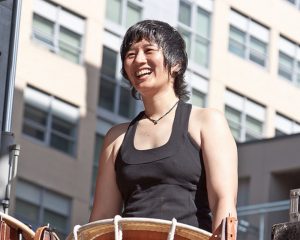Hi Edubloggers,
Today, I will continue my introduction to taiko drums, this time being the Shime Daiko Drums. Initially, there are two types of taiko drums, Byouchi Daiko (Tacked Drums such as Hira and Nagado Daikos,) and Tsukeshime Daiko (Tied drum, Shime and Okedaiko [Tubed shaped, rope tied drums similar to the Kakko drums.])

NOTE: URGENT URGENT URGENT: The style of this Taiko is Edo Bayashi (Old Tokyo Style), not Eisa Daiko (Okinawan taiko drumming.)
The Shime is a small drum with animal skins tied with rope on both sides. However it’s size, it has a very loud, high pitched sound that can easily be heard over lower-pitched drums. The hide is first stretched on metal hoops, then stretched over the body. Similar to the tsuzumi and to African talking drums, both drum heads are bound together with cords so that the drum heads are bound by each other. Like every taiko drum, they must be played with Bachi (Taiko Sticks.) Since it is very small however, you’ll need a lighter wood like Hou or Mongolia Tree Bark, or Hinoke or Japanese Cypress . Shime Daikos are played in a variation of Japanese Music Ensembles like Hayashi Kabuki Theater players, Traditional songs, Nagauta “long song,” and Taiko performances.

There are two types of Shimes. A Hogaku which the rim is typically painted black and is usually played on a stand called a teren (A low, lightweight stand used to hold a classical shime-daiko at a slight angle.) The drum is played with a stance where you are sitting on your feet instead of standing. The drum played when standing or the Matsuri or festival Shime Daiko come in five different sized depending on the rim as well as the thickness of the skin. The order bellow is thinnest to thickest.
- Namitsuke
- Nichogake
- Sanchogake
- Yonchogake
- Gochogake
If you know some Japanese, you’ll realize that from Nichogake to Gochogake have the actual numbers two to five.
Ni= 2
San= 3
Yon/Shi: 4
Go: 5
When using stands, they are called Dai in Japanese. We usually sit down and play it in a stance called Seiza, however, most festival groups play standing up in a stance which your core muscle is the same height as the drum. There are two ways Shimes are made. One way is the traditional rope-tied drum and the other which is the bolt-tied drum.

Unlike the Nagado Daiko which makes three sounds Don, Tsu and Ka, the Shime uses Ten for one hit or two hits of a loud and soft simultaneously happening, tere which is two hits, and tsu which you use gravity to hit the drum, as it is a very small sound.
I hope you got a good terminology of the Shime Daiko. If you need help, please feel free to leave a comment or visit this website. If not, still feel free to do so and leave a comment.
Bye